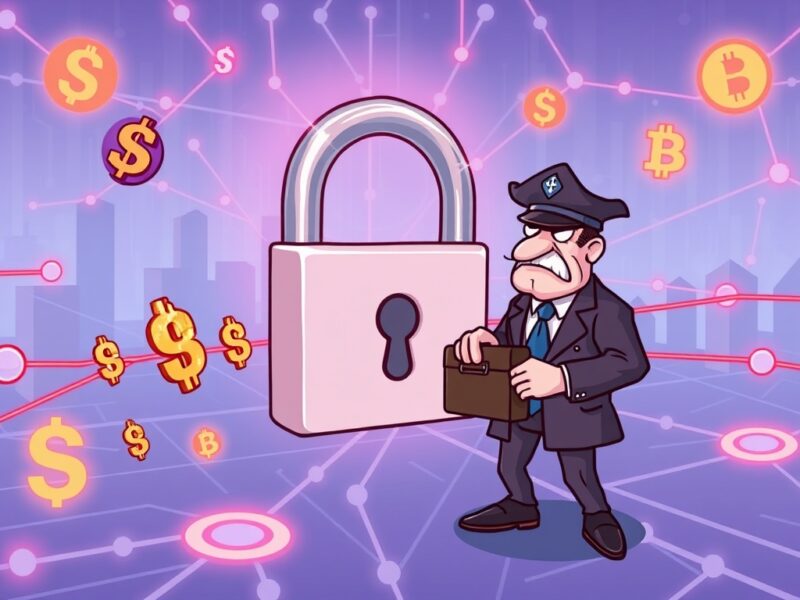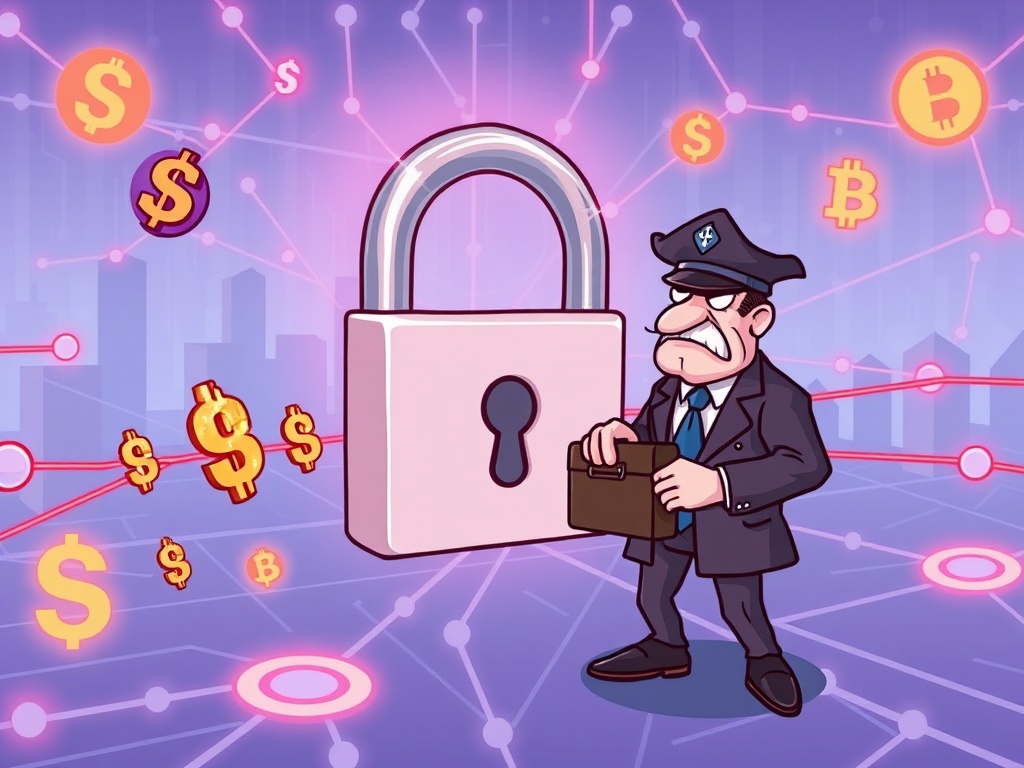WLFI Blacklisting: The Crucial Freeze of 272 Addresses and Justin Sun’s Bold Move
0
0

BitcoinWorld

WLFI Blacklisting: The Crucial Freeze of 272 Addresses and Justin Sun’s Bold Move
The world of cryptocurrency is often a whirlwind of innovation and unexpected turns. Recently, a significant development has sent ripples through the digital asset community: a major WLFI blacklisting event. Over the past week, a staggering 272 addresses have been blacklisted by WLFI, a move that has sparked considerable discussion and raised important questions about asset control in the decentralized space.
What is Behind the Recent WLFI Blacklisting Wave?
According to insights shared by Galaxy researcher Zach, the WLFI project has actively frozen assets linked to nearly three hundred unique addresses. This swift action highlights the project’s capacity to enforce its policies, even when it involves substantial amounts of digital wealth.
Blacklisting, in this context, refers to the process where a project or platform prevents specific wallet addresses from interacting with its ecosystem. This can mean freezing funds, restricting transactions, or blocking access to certain features. Such actions are typically taken to comply with regulatory requirements, prevent illicit activities, or address protocol violations.
The sheer number of addresses affected by this latest WLFI blacklisting underscores the scale of the operation. It’s a clear signal that the project is taking a firm stance on issues it deems critical to its integrity and operation.
Justin Sun’s Frozen Assets: A High-Stakes Game
Among the addresses caught in the crosshairs of the WLFI blacklisting was one belonging to Tron founder Justin Sun. This particular freeze was not minor; it involved approximately 3 billion WLFI, representing a significant portion of his holdings and a substantial sum in the market.
The freezing of such a prominent figure’s assets immediately drew widespread attention. It demonstrated that even high-profile individuals are not immune to these enforcement actions. This incident has, therefore, become a crucial case study in understanding the power dynamics within certain crypto ecosystems.
For Justin Sun, this WLFI blacklisting presented a direct challenge. His substantial investment in WLFI was effectively inaccessible, prompting a swift and strategic response to resolve the situation.
A Bold Counter-Move: Justin Sun’s Strategic Bid
In an apparent effort to have the freeze lifted, Justin Sun announced a distinctive plan. He publicly declared his intention to purchase $10 million worth of WLFI. Furthermore, he committed to acquiring an additional $10 million in Alt 5 Sigma (ALTS) stock, a company reportedly linked to Donald Trump.
This dual investment strategy suggests a multifaceted approach to resolving the asset freeze. Buying more WLFI could be seen as a gesture of confidence in the project, potentially aiming to demonstrate commitment and good faith. The inclusion of ALTS stock, with its high-profile association, adds another layer of intrigue to his strategy.
Whether this bold move will succeed in reversing the WLFI blacklisting remains to be seen. However, it certainly highlights the lengths to which major players are willing to go to protect and unfreeze their digital assets.
Understanding the Implications of WLFI Blacklisting
The recent WLFI blacklisting incidents carry significant implications for the broader cryptocurrency landscape. Firstly, they underscore the inherent tension between decentralization ideals and the practical need for control or regulation within some projects. While many crypto enthusiasts champion fully decentralized systems, this event shows that centralized control points can still exist and be exercised.
Secondly, it raises questions about asset security and the ultimate ownership of digital funds. When a project can unilaterally freeze assets, even for legitimate reasons, it prompts users to reconsider the true nature of their holdings on such platforms. It emphasizes the importance of understanding a project’s governance and its capabilities regarding user funds.
Finally, these actions can influence investor confidence. While some might see the blacklisting as a necessary step for maintaining ecosystem integrity, others might view it as a risk to their investments. This balance is crucial for the long-term health and adoption of any digital asset.
What Does This Mean for the Future of Digital Assets?
The ongoing saga of the WLFI blacklisting serves as a potent reminder of the evolving nature of the cryptocurrency space. As digital assets become more integrated into the global financial system, we can expect to see more instances where projects must navigate complex legal, ethical, and operational challenges.
For investors and users, the key takeaway is the importance of due diligence. Understanding a project’s terms, its team’s capabilities, and its governance model is paramount before committing significant capital. Events like these, while challenging, often lead to greater clarity and potentially more robust frameworks for asset management and security in the future.
In conclusion, the WLFI blacklisting of 272 addresses, including Justin Sun’s substantial holdings, marks a pivotal moment. It highlights the power of project governance, the strategic maneuvers of high-profile investors, and the ongoing dialogue about control and freedom in the world of digital assets. This event will undoubtedly contribute to the ongoing evolution of how we perceive and interact with our crypto investments.
Frequently Asked Questions (FAQs)
- What does WLFI blacklisting mean?
WLFI blacklisting refers to the act of the WLFI project preventing specific wallet addresses from interacting with its ecosystem, often resulting in the freezing of associated funds or restricted access to services. - How many addresses were affected by the recent WLFI blacklisting?
According to Galaxy researcher Zach, 272 addresses were blacklisted by WLFI over the past week. - Why was Justin Sun’s address blacklisted by WLFI?
The article states that Justin Sun’s address was blacklisted, freezing approximately 3 billion WLFI, but it does not specify the exact reason for his particular blacklisting. - What was Justin Sun’s response to the asset freeze?
Justin Sun announced plans to purchase $10 million worth of WLFI and an additional $10 million in Alt 5 Sigma (ALTS) stock, in an apparent bid to have the freeze lifted. - What are the broader implications of such blacklisting events?
Such events raise important questions about the balance between decentralization and control, asset security, and can influence investor confidence in digital asset projects.
If you found this article insightful, consider sharing it with your network on social media. Your shares help us bring crucial insights and analyses to a wider audience interested in the dynamic world of cryptocurrency.
To learn more about the latest crypto market trends, explore our article on key developments shaping digital assets institutional adoption.
This post WLFI Blacklisting: The Crucial Freeze of 272 Addresses and Justin Sun’s Bold Move first appeared on BitcoinWorld and is written by Editorial Team
0
0
 Manage all your crypto, NFT and DeFi from one place
Manage all your crypto, NFT and DeFi from one placeSecurely connect the portfolio you’re using to start.

